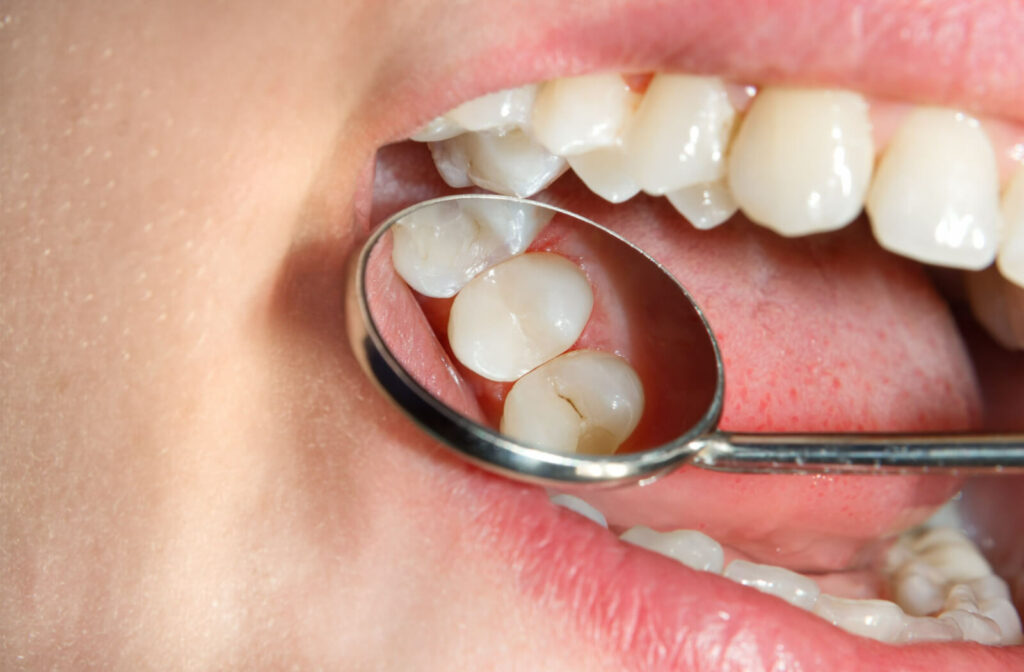Cavities are a common dental problem, although they are largely preventable.
Cavities can often begin developing with little to no physical symptoms. As they progress deeper into the tooth, you may notice a dull ache after eating sugary foods.
Further complications, like damage to the tooth’s root or surrounding teeth, can occur if the cavity continues untreated. A simple restorative dentistry procedure like a filling is often the only fix needed if the cavity is caught in time. But if the tooth decay-causing the cavity reaches the inner part of the tooth, a root canal may be necessary.
You shouldn’t have to worry about tooth decay progressing as long as you’re getting regular dental exams, cleaning, and taking care of your teeth properly between these appointments.
What Is a Cavity?
A cavity is a pit or hole in the tooth’s enamel layer. It typically begins with tooth decay that develops when plaque builds up on the tooth. The plaque-causing bacteria start eating away at the enamel layer. Once it breaks through the enamel, it continues through the dentin and into the inner part of the tooth, called the pulp, if left untreated.
Cavities are common in children due to improper brushing. Over half of kids have had a cavity by the time they’re 19. But 96% of adults have had cavities throughout their lives as well.

What Does a Cavity Feel Like?
You typically won’t have any physical symptoms when a cavity begins forming. But you may notice white spots that turn brown as the tooth decay begins demineralizing the tooth and eating away at the enamel.
Then, as the cavity reaches the dentin layer, you’ll likely begin experiencing tooth sensitivity, and the spots may darken in colour. And if it continues untreated from there, you’ll probably experience more discomfort, and eventually, the pain may radiate throughout your jaw.
Treating a Cavity
Treatment of cavities depends on the stage of development and type of cavity. Your dentist can recommend treatment during a dental exam.
Some common cavity treatments can include the following.
Filling
A filling is the most common form of treatment for a cavity. This involves removing the tooth decay, then the clean hole is filled to prevent recurrent decay. Common filling materials are dental amalgam or composite material.
Root Canal
A filling may not be an option if the cavity reaches the inner parts of your tooth. A root canal may be the best option in this case. The dentist removes the damaged tissue from the inside of the root and crown of the tooth. Once the tooth is cleaned out, a crown is a common way to finish the procedure, but the opening can also be sealed with gutta-percha.
Crown
Tooth decay will ultimately impact the tooth’s structure. Your dentist may recommend a crown when tooth decay has damaged large portions of the tooth. Not only can a crown protect against further decay, but it also enhances the tooth’s structural integrity to make it stronger after being affected by the tooth decay.
Extraction
Although it’s typically a last resort, tooth extraction may sometimes be necessary to protect the rest of your mouth. Your dentist may recommend removing the tooth if the decay cannot be cleaned enough to prevent the spread of infection or if it’s damaged too much of the tooth’s structure.
Cavity Prevention
There are a few things you can do to help minimize the chances of developing cavities.
Proper Oral Hygiene
A good oral hygiene routine is at the forefront of cavity prevention. Following the Canadian Dental Association’s (CDA) recommendations for brushing and flossing is a solid start. This includes brushing at least twice daily and flossing at least once. But preferably after every meal. Mouthwash can also be a great addition to your daily routine, but it should never replace proper brushing and flossing.
Good Lifestyle Habits
Avoiding sweet and starchy foods, especially between meals, is a good idea. This can help prevent bacteria growth. Also, avoiding sugary or acidic drinks can help prevent the enamel from wearing down on your teeth.
Regular Visits to the Dentist
The CDA recommends that most people visit their dentist for an exam and cleaning at least every 6 months. Your dentist may recommend more frequent visits if you’re prone to experiencing cavities.
Discuss Your Symptoms with Your Dentist
The sooner a cavity is caught and treated, the better, as we can see from how they progress. Whether you’re noticing the first signs of a cavity developing or you’re beginning to experience some discomfort, give us a call at Viceroy Dental.
Our team can get you in to see one of our experienced dentists to perform a dental exam and treat the cavity if needed.


